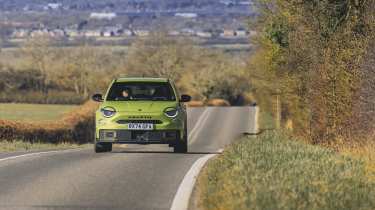Abarth 600e – powertrain and technical highlights
A new, more potent electric motor and a proper mechanical limited-slip differential contribute to its high output and engaging drive
If you’re familiar with the Alfa Romeo Junior you’ll have a good idea of what lies under the 600e’s skin. The 600e Scorpionissima tops the range with a Junior Veloce-matching 276bhp and 254lb ft of torque, delivered to the front wheels via a mechanical Torsen limited-slip differential – the motor that delivers this power is a bespoke in-house developed unit designed specifically for performance models. For comparison, the Abarth 500e produces a comparatively measly 152bhp and 173lb ft of torque.
The primary on-paper difference between the Alfa Romeo Junior and this, is that the standard 600e is available in a lower 237bhp state of tune, something that’s currently missing from the Alfa range – torque is unchanged at 254lb ft, with all underlying mechanics (limited-slip differential included) the same as the range-topper.
With the potent motor pulling power from the standard 54kWh e-CMP battery pack, there was some work to do in the heat management department. Stellantis engineers worked to develop a new cooling system for the powertrain for this reason, making it capable of a full lap of the Nürburgring without restricting performance (something that can’t be said for most EVs).
One of the Abarth’s key USPs is the interior and exterior sound generator, a system carried across from the 500e. Fitted as standard only to the Scorpionissima, it’s less obnoxious than the system in its smaller relative, lower in volume and with a more convincing tone at idle. Revving at a standstill is still a party trick worth skipping, with the idle sound track playing constantly beneath the synthetic revs for a less convincing effect.
Inside and on the move, the sound is as loud as that of a modern hot hatchback, with no artificial gearshifts. While this does make it sound a little like a CVT, the sound is well-judged on the whole, providing a greater sense of speed than you have without it. What we’d like to see, though, is this synthetic sound be more in-tune with wheel speed, offering a greater sense of traction loss and load to further enhance feedback – the 600e’s sound isn’t granular enough to reflect momentary traction loss, and actually masks the tyre sound you’d ordinary use as a reference point. In my experience, the CVT-like, gear-less sound also makes acceleration feel less dramatic than with the sound generator turned off.
With the system easily deactivated in four steps via the central infotainment display, a brief stint with the sound turned off on track did make it clear that the sound provides benefit when pushing on, though, acting as an additional way to gauge speed. Admittedly, we felt the need to turn it off through quiet British villages out of embarrassment, but it’s a nifty feature to have at your disposal.




